Our website is supported by our users. We sometimes earn money when you click an affiliate link and make a purchase. This is at no extra cost to you and helps us to create quality content. For all that have shown us such wonderful support, we thank you from the bottom of our hearts!
Bulldogs, one of the most popular dog breeds, are known for their distinct appearance and loyal nature.
Originally bred for bull baiting in England, these dogs have come a long way and are now considered ideal family pets.
Their unique “sourmug” face, muscular build, and short, glossy coat make them easily recognizable and charming companions.

There are several types of bulldogs, with the English Bulldog and American Bulldog being two of the most well-known.
The English Bulldog (British Bulldog, Olde English Bulldogge) is a medium-sized breed characterized by its large head, thick folds of skin, and relatively flat face with a protruding lower jaw.
On the other hand, the American Bulldog is a larger, more athletic variant, often sporting a white or patchy coat and a similarly muscular build.
As you learn more about bulldogs, you’ll discover their various traits and characteristics that make them ideal family pets.
These breeds are known for their friendly and courageous demeanor, and with proper care, training, and socialization, they can become loving and docile additions to your home.
History
This canine has a rich history that dates back to the 5th century in England.
Initially, early bulldogs were used to help butchers and farmers control livestock, and the first mention of these dogs was referenced in literature around 1500 as “bondage” or “bolddogge.”
You might be surprised to learn that Bulldogs, hence the name, were later used in the infamous and now-outlawed sport of bull-baiting, which began in the 1500s in England.
These dogs were valued for their tenacity and strength, making them perfect candidates for such blood sports.
Their stocky build and compact bodies allowed them to dodge and be effective against their bovine adversaries.
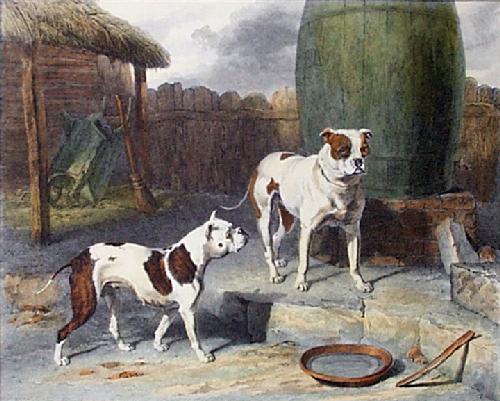
Origin and Transition
As time passed, public opinion shifted, and bull-baiting became illegal in 1835.
At this point, the fate of this breed was uncertain.
However, dedicated breeders stepped in and focused their efforts on preserving the breed while also eliminating its more aggressive qualities.
Consequently, today’s Bulldogs are known as gentle and family-friendly companions, a significant departure from their early history.
The old English version is, in fact, the ancestor of the current breed, which has been transformed over centuries.
The bulldog in history looks a bit different than the breed standard today.
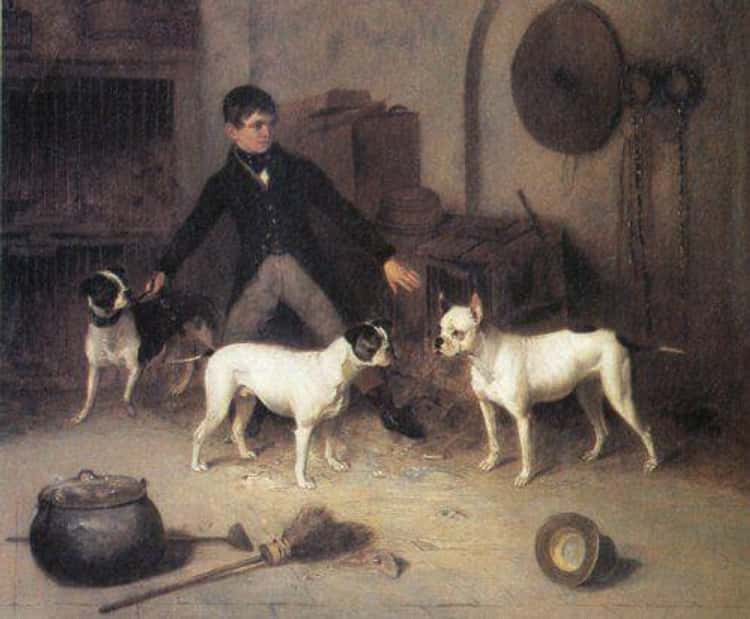
Recognition by Kennel Clubs
Eventually, the Bulldog gained recognition from esteemed organizations like the American Kennel Club (AKC) in the United States.
Established in 1886, the AKC provides valuable resources and support to purebred dog enthusiasts, playing an essential role in documenting and maintaining breed standards.
Similarly, the Bulldog Club of America was founded in 1890, with the mission to preserve and protect the integrity of the breed, as well as promote responsible breeding practices.
This club has a strong commitment to the health and wellbeing of Bulldogs, ensuring that the breed’s history remains respected and acknowledged.
In summary, your understanding of the dog’s history begins with its origins in livestock control and brutal bull-baiting in England.
Thanks to committed breed enthusiasts, the Bulldog transformed into a beloved family pet recognized by prestigious breed clubs like the AKC and Bulldog Club of America.
Physical Characteristics
Bulldogs are muscular dogs with short legs, wide shoulders, a short muzzle and wrinkly skin.
Height Male
Males typically have a height ranging from 12 to 16 inches. Their stocky build and wide stance contribute to their unique appearance.
Height Female
Females are slightly smaller than males, usually standing between 11 and 15 inches tall. They share the same characteristic stocky build as their male counterparts.
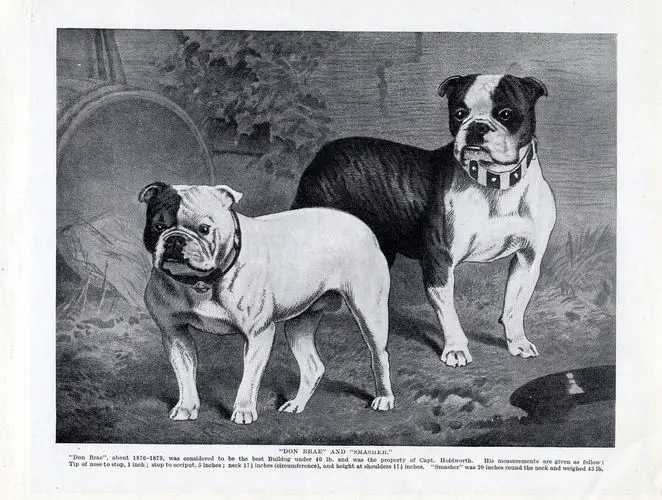
Weight Male
Males tend to have a heavier build, weighing between 50 and 55 pounds. Their substantial frame is a key element of their physique, making them a sturdy and powerful breed.
Weight Female
Females are lighter than males, with weights generally ranging between 40 and 50 pounds. This weight, combined with their shorter height, gives them a petite yet muscular appearance.
Eye Colors
They have distinct and expressive eyes that come in various shades of brown, ranging from light to dark.
Their eyes are medium-sized and set low and wide on their large heads.
Coat Colors
They come in an array of coat colors including red, white, fawn, tan, brindle, and piebald.
The breed has considerable variation in color patterns, sometimes displaying a combination of two or more colors.
Coat Types
The bulldog’s coat is predominantly short, smooth, and close-fitting.
Their coats are relatively low maintenance, only requiring occasional grooming to remove loose hair and maintain a healthy appearance.
Life Expectancy
In general, these dogs have a life expectancy of 8 to 10 years.
To ensure your dog lives a long and healthy life, it is important to provide regular care, including a balanced diet, exercise, and routine veterinary check-ups.
Maintaining a healthy weight and monitoring for any health issues specific to the breed can also contribute to their overall well-being.
Temperament & Training
Bulldogs are known for their distinctive, wrinkled faces and powerful, loose skin stocky bodies.
Their personalities boast a combination of affectionate, dignified, and sometimes even comical traits.
In this section, you will learn about the temperament and training of this breed.
First, let’s discuss some of the main aspects of their temperament.
They are generally a friendly, loyal, and affectionate breed, known to be especially gentle and loving towards children.
They are also quite docile, which usually means they are great family dogs get along with other pets.
Their courage and strong demeanor help protect their loved ones, but it is essential to remember that they are not known for aggressive behavior.
Future pet parents should know that they are a brachycephalic breed which means they are flat-faced dogs with short snouts.
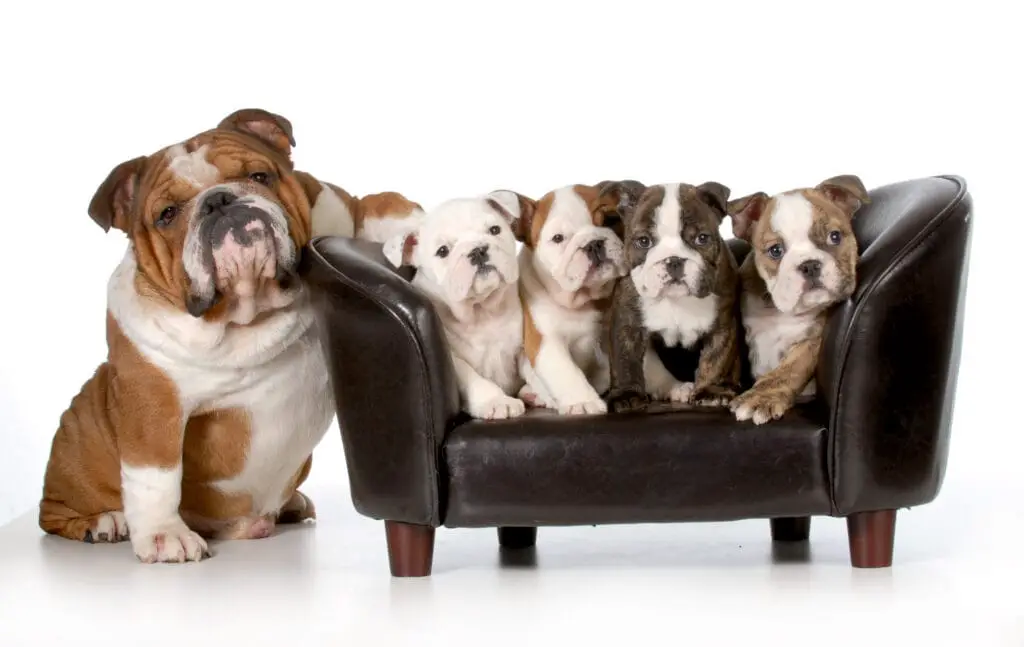
Therefore, they may at times have difficulty breathing and regulating their temperature.
Therefore they only need moderate exercise with constant monitoring so that they don’t overheat. This is especially true in warm weather.
However, these dogs are known for their stubbornness.
This can present challenges when it comes to training.
But with patience, consistency, and positive reinforcement, you can navigate this aspect of their personality.
Establishing leadership early on is key to managing your dog’s stubborn streak.
Although they may not be the most obedient breed at first, dogs have the potential to learn commands and good behavior with proper guidance.
Here are a few training tips for your Bulldog:
- Start early: The sooner you begin training, the easier it will be to develop good habits.
- Consistency is key: Be consistent with the rules and expectations you set for your dog.
- Positive reinforcement: Reward good behavior with praise, treats, or toys. Avoid punishment or scolding.
- Socialize: Expose your dog to various environments, people, and animals to help them become well-rounded and confident.
- Patience: Training your dog will require time and dedication, so remain patient and understanding of their needs.
Remember, these dogs make excellent pets with their sweet, gentle nature, and impressive working abilities.
While training can be a challenge due to their stubbornness, the efforts you invest in shaping their behavior will undoubtedly pay off.
With proper training, you will have a loyal, loving, and courageous companion by your side.
So, embrace your dog’s unique temperament, and enjoy the journey of building a strong, lifelong bond together.
Health Issues
Along with other bulldog-type breeds, Bulldogs have a few known health issues.
Brachycephalic Obstructive Airway Syndrome (BOAS)
One of the health concerns that Bulldogs are prone to is Brachycephalic Obstructive Airway Syndrome (BOAS) due to their shortened facial features, which result in a pushed-in nose.
This brachycephalic syndrome causes difficulty in breathing and can lead to overheating, especially during hot weather or when exercising.
To reduce the risks associated with BOAS, you must provide them with moderate exercise, monitor them during exercise especially when it’s warm out and avoid overexertion.
Obesity
Due to only getting moderate exercise, it is important to monitor for weight gain.
Obesity can increase the severity of BOAS due to increasing pressure of excess fat around the neck area increasing breathing difficulties.
That means though you want to spoil your Bully, overfeeding them can make them very uncomfortable.
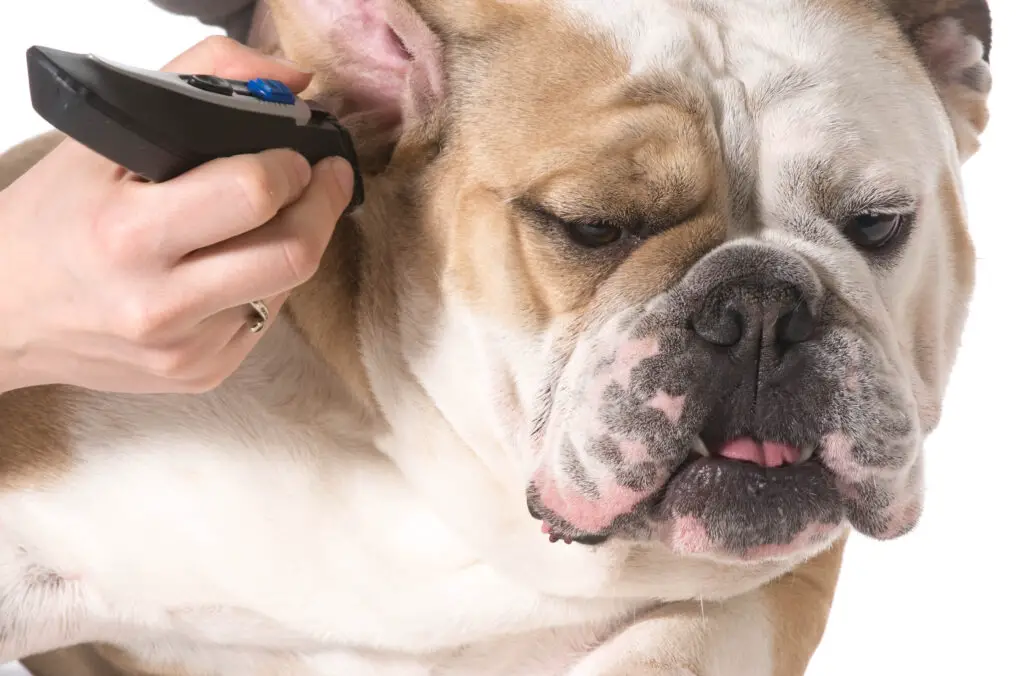
Eye Conditions
Bulldogs tend to develop various eye conditions due to their physical characteristics.
One such issue is cherry eye – an inflammation of the gland around the eye.
Another common eye disorder is entropion, where the eyelids fold inwards, causing irritation to the eye.
It is essential to monitor your Bulldog’s eyes and consult with your veterinarian if you observe any signs of inflammation or discomfort.
Skin Conditions
Your Bulldog is also more prone to skin problems such as allergies, skin infections, and skin fold dermatitis.
These issues can cause itchiness, redness, and pain in affected areas.
To prevent infections, it is crucial to clean and dry the skin folds regularly and provide appropriate grooming routines.
Regular allergy tests can help identify triggers and devise appropriate measures to minimize their impact.
Some helpful tips to maintain your Bulldog’s health are:
- Regular vet checkups – to identify potential health issues early on.
- Maintain a healthy diet – to prevent obesity and related health problems.
- Grooming routines – to avoid skin infections and other skin conditions.
- Monitor exercise levels – to prevent overheating and undue stress on joints.
Remember, taking care of your dog’s health is vital for their well-being and overall quality of life.
By staying informed and proactive, you can ensure that your furry companion thrives and lives a happy life.
Grooming
Brushing
Brushing your bulldog’s short coat is essential for removing dead hair and skin cells, and evenly distributing natural oils throughout the coat.
To keep your bulldog’s coat smooth and shiny, brush it daily or at least a few times a week using a bristle brush.
Bathing
Bulldogs should be bathed once every 1-3 months, depending on their activity level and how much dirt they get into.
Always use a gentle, hypoallergenic shampoo to avoid skin irritation.
Thoroughly towel dry your bulldog after the bath or whenever they get wet, making sure to dry in between skin folds to prevent skin infections.
Cutting Fur/Hair
Bulldogs have short coats, so they typically don’t need their fur trimmed.
However, if you notice any long hairs or uneven patches in their coat, you may use a pair of grooming scissors or trimmers to carefully cut and even out their fur.
Clipping or Grinding Nails
Regularly trim your bulldog’s nails to keep them at a healthy length.
You can use nail clippers or a dremel-style nail grinder designed for dogs.
Make sure to be cautious and avoid cutting the quick (the blood vessel in the nail), as this can cause pain and bleeding. However, if you unintentionally cut the quick, use styptic powder in order to stop the bleeding
For more information, check out our article: How to Grind Your Dog’s Nails Safely and How to Clip a Dog’s Nails Safely.
Dental Care
Maintaining your bulldog’s dental health is important to prevent bad breath, gum disease, and tooth loss.
You should brush your bulldog’s teeth every day with a canine toothpaste and toothbrush.
Offering dental chews and toys can also help with their dental care.
Cleaning Ears
Bulldogs are prone to ear infections, so it’s crucial to regularly clean their ears.
Use a cotton ball dipped in a gentle ear cleaning solution (avoid using peroxide) to wipe out any dirt or debris.
These Pet MD Dog Ear Cleaner Wipes are compact and portable which makes them convenient to take them anywhere.
More information on cleaning your bulldog’s ears can be found on Rover.
Owning
Cost of Purchase
Purchasing can be quite expensive due to their popularity and breeding challenges.
Prices may vary depending on the breeder’s reputation, the pedigree of the dog, and location.
It is essential to budget accordingly and keep in mind that high costs don’t always guarantee good health or temperament.
Maintenance Costs
Owning this breed comes with a variety of maintenance costs that you must consider. Here is an overview of some of the expenses you may encounter:
- Food: These dogs tend to have food allergies, which may require time and money to address by finding the right diet.
- Grooming: Regular grooming is essential for Bulldogs due to their wrinkles and folds. Keep them clean and dry to prevent infections.
- Medical expenses: They are prone to health issues that may require frequent visits to the vet and possibly special care.
- Special training: While these dogs are known for their friendly and calm nature, they may require additional training in obedience or socialization.

Adopting a Bulldog
An alternative to purchasing a Bulldog from a breeder is adopting from a rescue organization.
Bulldog rescues help find new homes for abandoned or surrendered dogs, often saving them from euthanasia.
The Bulldog Club of America provides information on adoption and what to expect when owning this breed.
Adopting a dog can be a rewarding experience and often comes with lower initial costs compared to purchasing from a breeder.
However, it is essential to understand that adopted dogs may still have health issues or require additional training.

Finding Reputable Breeders
If you decide to purchase a puppy from a breeder, it is crucial to find a reputable one.
The American Kennel Club and the Bulldog Club of America can provide guidance on finding reputable breeders.
Things to consider when choosing a breeder:
- Ensure they have appropriate health certifications for both sire and dam.
- Check the breeding facilities to gauge cleanliness and overall care.
- Look into the breeder’s reputation. Get references from past buyers.
- Ask for a written contract covering your new dog’s health and any guarantees.
By doing proper research and finding a reputable breeder, you can increase your chances of bringing home a healthy and well-adjusted dog.
Frequently Asked Questions
What are the common health issues associated with Bulldogs?
Bulldogs are prone to a number of health issues, such as breathing problems due to their short snouts, hip dysplasia, eye problems, and skin fold infections.
It’s important to keep an eye on your Bulldog’s health and maintain regular vet check-ups to detect and manage these issues early on.
How much does a Bulldog typically weigh?
A healthy adult usually weighs between 40 to 50 pounds.
Males tend to be slightly heavier than females.
Keep in mind that every dog is different, and weight can vary depending on factors like genetics, diet, and activity level.
Which breeds are commonly mixed with Bulldogs?
Bulldogs are often mixed with other breeds to create designer dogs.
Common mixes include the Bull Pug (Bulldog and Pug), Beabull (Bulldog and Beagle), and Bulldoxer (Bulldog and Boxer).
These hybrids often show traits from both parent breeds, making them unique, yet retaining the characteristic Bulldog charm.
What are some distinct characteristics of Bulldog puppies?
Bulldog puppies are known for their adorable, wrinkled faces and stout build.
They display a playful, affectionate personality and are quite intelligent.
It’s important to train and socialize your Bulldog puppy early on to ensure they grow into a well-rounded, well-behaved adult.
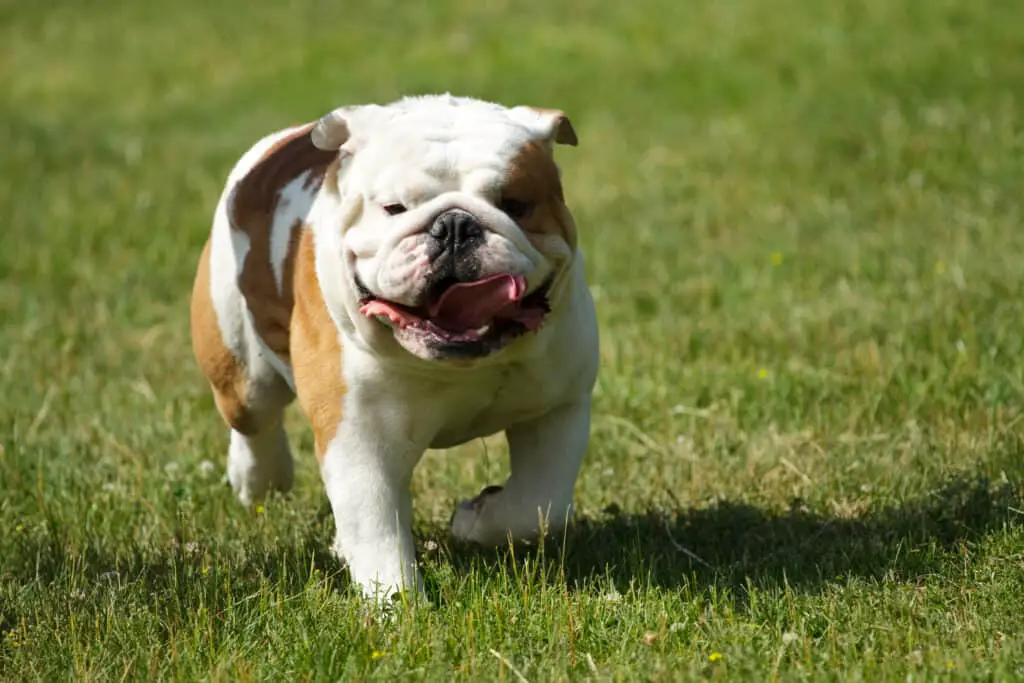
How can I identify a Bulldog among other wrinkle-faced dog breeds?
These dogs are characterized by their wrinkled face, broad head, distinct pushed-in nose, and stocky, muscular body.
Their ears are typically folded over, known as “rose-shaped ears.” Their tails are naturally short and may have a slight curl.
What care considerations are important for Bulldog owners to know?
Proper care for your dog includes monitoring their weight, providing a balanced diet, and ensuring they get regular exercise.
They are susceptible to overheating due to their short snouts, so avoid long walks or outdoor activities in hot weather.
Grooming is important too, as their facial wrinkles need regular cleaning to prevent infection.
Additionally, they may require more specialized dental care than other breeds.
Conclusion: Bottom Line

When considering a bulldog as your potential family pet, it’s essential to understand their natural temperament, traits, and needs.
Bulldogs, including the American Bulldog and English Bulldog, are known for being loyal and affectionate, making them great companions for families and individuals seeking a friendly furry pal.
A few key characteristics to keep in mind:
- These dogs thrive on companionship and bond deeply with their families.
- They are adaptable, fitting seamlessly into various lifestyles, whether urban or rural.
- They possess a calm demeanor and are well-suited as companion dogs.
As with any dog breed, it is crucial to educate yourself on the specific needs of your bulldog.
Familiarize yourself with their health, grooming, and exercise requirements to ensure you create a comfortable and happy environment for your new pet.
A happy bulldog will undoubtedly be a loyal and loving addition to your life, bringing you a unique companionship experience unlike any other.
In summary, bulldogs can make excellent family pets with their lovable nature, strong loyalty, and adaptability to various environments.
By understanding their specific traits and requirements, you can successfully integrate a bulldog into your life, making a lasting, rewarding friendship.
Please read our Legal Disclaimer






